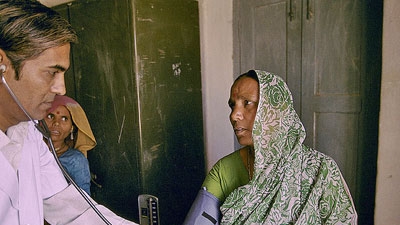Globally, tuberculosis affects some 8.7 million people. Women and children in the developing world are particularly vulnerable. The disease has high mortality rates, but even for survivors, the consequences can be debilitating, with long-term health consequences. Highly effective treatments are free and available to patients in developing countries, but many of those infected with TB are neither diagnosed nor in treatment. The under-detection of TB represents a key challenge for health officials in developing countries because identifying those who have the disease is crucial to the success of any treatment program.
| Research area: | Health |
| Country: | India |
| Evaluation Sample: | 3,182 patients at 128 tuberculosis (TB) treatment centers |
| Timeline: | 2014 – 2017 (Completed, endline report pending) |
| Intervention: | cash transfers, information |
| Researchers: | Jessica Goldberg, University of Maryland; Mario Macis, Johns Hopkins University; Jason Farley, Johns Hopkins University |
| Partners: | J-PAL South Asia; Operation ASHA |
Problem
According to the WHO, India has the highest burden of tuberculosis (TB) in the world; of the 10 million people who developed active TB in 2016, about 3 million were Indian. Close to 40 percent of those infected either haven’t been diagnosed or aren’t receiving treatment. In addition to the health effects, the impact on the Indian economy is significant: annual lost wages because of the disease are estimated to be some US $330 million dollars. Infected people are disproportionately from vulnerable and marginalized populations and outreach is costly in terms of time and resources. Also, those who suffer from the disease often don’t know about the availability and effectiveness of treatment.
Intervention
The India-based non-governmental organization Operation ASHA, which operates 200 tuberculosis treatment centers and is part of India’s National TB Control Programme, explored different outreach approaches to improve identification and treatment of new patients. The program offered cash payments to current patients who referred people who might
have tuberculosis to government testing centers. The program was structured to test the different approaches for finding new TB positive people, including extra payments if the person referred tested positive for the disease. It was implemented between 2016 and 2017.
Evaluation Design
The evaluation was set up as a randomized controlled trial with 9 experimental groups and a control group. In the control group, patients in clinics received no additional intervention to encourage referrals. In one treatment group, they were given referral cards and encouraged to give these out to people who they though should be tested for TB. In another treatment group, patients got the referral cards and also Rs. 150 (about US $3.00) for every new patient that came for TB screening with one of the cards. In a third treatment group, patients were given Rs. 100 (US $2.00) for every person that came to the clinic for screening, and also received a Rs. 150 bonus if the new referral tested positive. The study was also designed to test different outreach approaches. In one group, patients approached their peers directly; in another they were encouraged to provide the names of people they thought should be approached by a health worker for TB screening, and the patients’ names were not revealed; in the third group, patients provided names and health workers told people who had referred them.
Eligibility
TB patients currently seeking treatment with Operation ASHA and those who have completed treatment within 3 months of the start of baseline data collection.
Results
First, financial incentives were effective in increasing the number of new suspects who get screened or tested. Second, outreach conducted through peers was more effective than the current standard of outreach by trained health workers in encouraging referrals to visit screening centers. Third, making the financial reward conditional on the suspect showing symptoms of TB did not discourage referrals, which means that conditionality can be used to prevent gaming of the incentive system.
Next Steps
The State Tuberculosis Department in Delhi has expressed a keen interest in piloting the referral program in the health clinics directly under their purview. Details are provided below.
